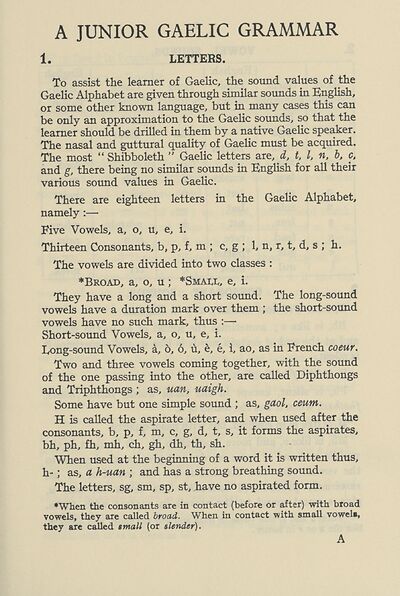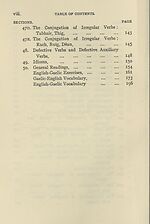Download files
Complete book:
Individual page:
Thumbnail gallery: Grid view | List view

A JUNIOR GAELIC GRAMMAR
1. LETTERS.
To assist the learner of Gaelic, the sound values of the
Gaelic Alphabet are given through similar sounds in English,
or some other known language, but in many cases this can
be only an approximation to the Gaelic sounds, so that the
learner should be drilled in them by a native Gaelic speaker.
The nasal and guttural quality of Gaelic must be acquired.
The most “Shibboleth ” Gaelic letters are, d, t, l, n, b, c,
and g, there being no similar sounds in English for all their
various sound values in Gaelic.
There are eighteen letters in the Gaelic Alphabet,
namely :—
Five Vowels, a, o, u, e, i.
Thirteen Consonants, b, p, f, m ; c, g ; 1, n, r, t, d, s ; h.
The vowels are divided into two classes :
♦Broad, a, o, u ; *Smald, e, i.
They have a long and a short sound. The long-sound
vowels have a duration mark over them ; the short-sound
vowels have no such mark, thus :—•
Short-sound Vowels, a, o, u, e, i.
Eong-sound Vowels, a, 6, 6, li, e, e, 1, ao, as in French coeur.
Two and three vowels coming together, with the sound
of the one passing into the other, are called Diphthongs
and Triphthongs ; as, uan, uaigh.
Some have but one simple sound ; as, gaol, ceum.
H is called the aspirate letter, and when used after the
consonants, b, p, f, m, c, g, d, t, s, it forms the aspirates,
bh, ph, fh, mh, ch, gh, dh, th, sh.
When used at the beginning of a word it is written thus,
h-; as, a h-uan ; and has a strong breathing sound.
The letters, sg, sm, sp, st, have no aspirated form.
♦When the consonants are in contact (before or after) with broad
vowels, they are called broad. When in contact with small vowel*,
they are called small (or slender).
A
1. LETTERS.
To assist the learner of Gaelic, the sound values of the
Gaelic Alphabet are given through similar sounds in English,
or some other known language, but in many cases this can
be only an approximation to the Gaelic sounds, so that the
learner should be drilled in them by a native Gaelic speaker.
The nasal and guttural quality of Gaelic must be acquired.
The most “Shibboleth ” Gaelic letters are, d, t, l, n, b, c,
and g, there being no similar sounds in English for all their
various sound values in Gaelic.
There are eighteen letters in the Gaelic Alphabet,
namely :—
Five Vowels, a, o, u, e, i.
Thirteen Consonants, b, p, f, m ; c, g ; 1, n, r, t, d, s ; h.
The vowels are divided into two classes :
♦Broad, a, o, u ; *Smald, e, i.
They have a long and a short sound. The long-sound
vowels have a duration mark over them ; the short-sound
vowels have no such mark, thus :—•
Short-sound Vowels, a, o, u, e, i.
Eong-sound Vowels, a, 6, 6, li, e, e, 1, ao, as in French coeur.
Two and three vowels coming together, with the sound
of the one passing into the other, are called Diphthongs
and Triphthongs ; as, uan, uaigh.
Some have but one simple sound ; as, gaol, ceum.
H is called the aspirate letter, and when used after the
consonants, b, p, f, m, c, g, d, t, s, it forms the aspirates,
bh, ph, fh, mh, ch, gh, dh, th, sh.
When used at the beginning of a word it is written thus,
h-; as, a h-uan ; and has a strong breathing sound.
The letters, sg, sm, sp, st, have no aspirated form.
♦When the consonants are in contact (before or after) with broad
vowels, they are called broad. When in contact with small vowel*,
they are called small (or slender).
A
Set display mode to:
![]() Universal Viewer |
Universal Viewer | ![]() Mirador |
Large image | Transcription
Mirador |
Large image | Transcription
| An Comunn Gàidhealach > An Comunn Gàidhealach Publications > Elementary course of Gaelic > (13) |
|---|
| Permanent URL | https://digital.nls.uk/196026888 |
|---|
| Description | This contains items published by An Comunn, which are not specifically Mòd-related. It includes journals, annual reports and corporate documents, policy statements, educational resources and published plays and literature. It is arranged alphabetically by title. |
|---|
| Description | A collection of over 400 items published by An Comunn Gàidhealach, the organisation which promotes Gaelic language and culture and organises the Royal National Mòd. Dating from 1891 up to the present day, the collection includes journals and newspapers, annual reports, educational materials, national Mòd programmes, published Mòd literature and music. |
|---|---|
| Additional NLS resources: |
|

